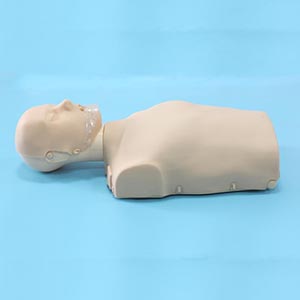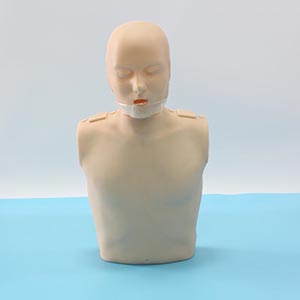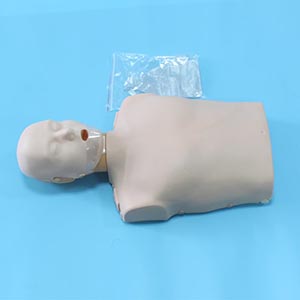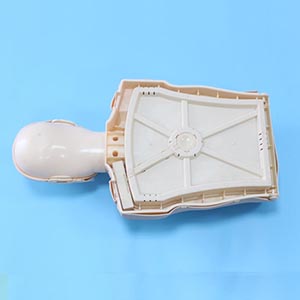Half-body cardiopulmonary resuscitation simulator (hereinafter referred to as "half-body simulator") has been widely used in medical emergency training in recent years. It is not only an effective tool for improving cardiopulmonary resuscitation (CPR) skills, but also a catalyst for first aid education, research and technological innovation. For medical students, understanding the multiple functions and values behind the hemibody not only helps to improve clinical skills, but also provides valuable implications for future development in the field of emergency care.

Half Body cardiopulmonary resuscitation Simulator
1. The technological advancement of the hemibody has promoted the development of medical education
Hemitorso is not only a static teaching model, it integrates modern medical simulation technology to make first-aid training more close to the real situation. Traditional cardiopulmonary resuscitation training models are mostly simple mechanical devices, which cannot provide detailed physiological feedback. Modern hemisimulators use sophisticated sensors, simulation systems, and physiological monitoring technology to simulate a patient's physiological response in real time.
For example, some hemibusts are equipped with lung airway pressure sensors, heart rate monitoring devices, and chest rebound pressure feedback systems. These techniques allow students to feel the depth, frequency, and effect of chest rebound while performing CPR in real time. These details are critical for medical students, as proper CPR techniques require precise manipulation, and this real-time feedback helps students constantly fine-tune their technique and improve their skill proficiency.
According to a study in the Journal of Medical Simulation and Education, participants who trained in first aid using simulators with real-time feedback systems improved their CPR success by about 30 percent compared to traditional training. This data shows that the hemibusts not only provide more practical opportunities, but also significantly improve the training results of the trainees.

2. Hemibusts have promoted the standardization of first aid education
With the popularization of halflons, the standardization and standardization of first aid training have been further strengthened. In many medical institutions and teaching hospitals, hemibusts have become a core component of CPR training courses. With uniform training standards, medical students can receive the same training in a variety of emergency Settings without having to rely on simulations of actual patients. This not only improves the efficiency of education, but also ensures the quality of training.
For example, international medical organizations such as ** the American Heart Association (AHA) ** and ** the European Society of Cardiology (ESC) ** have incorporated standardized training for CPR into their certification systems and recommend the use of high-quality simulation tools. Through standardized training, students are able to master the standardized process of cardiopulmonary resuscitation, which is essential for future emergency response ability when entering clinical practice.

The hemibums have promoted research and innovation in first aid
In addition to its application in education, hemibusts are powerful tools for emergency research. Medical researchers use these high-fidelity simulators to test and validate various first-aid techniques and equipment. For example, many hospitals and research institutions use hemibumists to study key factors in CPR operations, such as chest compression depth, frequency, airway management, etc., to optimize emergency procedures and improve survival.
A study conducted by the Harvard Medical School has shown that by using an advanced hemibuccal model, researchers were able to effectively assess the impact of different CPR techniques on patients' physiological responses and provide a wealth of data to support improvements in cardiopulmonary resuscitation techniques. This kind of research not only drives technological innovation in the field of emergency care, but also provides medical students with cutting-edge knowledge and practical experience.

4. The semi-human as a bridge to clinical practice
In clinical medical education, students are often faced with the problem of disconnection between theory and practice. Although academic courses and book knowledge can provide students with a theoretical framework, the lack of adequate practical opportunities can affect their decision-making ability and executive ability in emergency situations. Hemibusts fill this gap by providing a "near-real" training environment.
** Data Support ** : A survey of medical students found that 80 percent of respondents said they made correct decisions faster in clinical emergency scenarios after training with a hemibody. Especially in critical moments, simulation training helps students master the technical details more skillfully, thus improving the accuracy and success rate of actual operation.
5. Multidisciplinary application of Halfling
It is important to note that halfling is not limited to first aid training, and its applications extend far beyond traditional medical education. Many clinical skills training in the fields of emergency medicine, surgery, anesthesiology, etc., also began to widely use hemibumists. For example, anesthesiology students can use these simulators for airway management training, and simulators can help students improve clinical judgment and emergency response speed when simulating respiratory obstruction or airway management failure scenarios.
In addition, hemibumists can also be used in research and clinical trials of emergency drugs. In some drug trials, simulated people can be used as experimental objects to evaluate the effect of drugs on cardiopulmonary resuscitation, so as to provide data support for the development of new drugs.
A CPR simulator goes far beyond a simple training tool. It not only improves the practical skills of medical students, but also plays an indispensable role in the standardization of first aid education, the research and innovation of first aid technology, and the bridge of clinical practice. Through more accurate simulation techniques and data feedback, the hemitorso not only allows students to have a more efficient training experience in the classroom, but also provides strong support for the future development of emergency medicine.
For medical students, understanding the multiple meanings behind hemibumists can not only help them build a bridge between theory and practice, but also provide a solid foundation for them to become qualified clinicians in the future.
